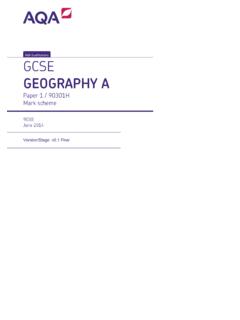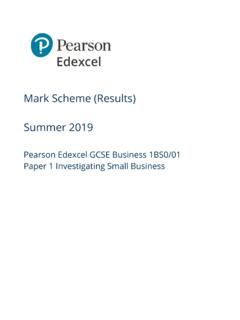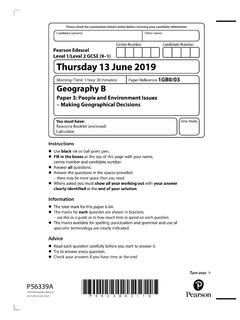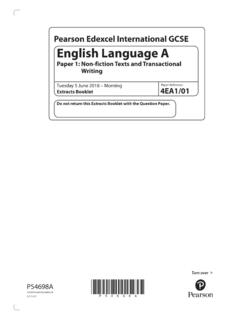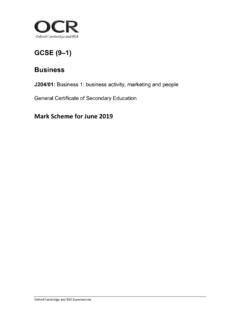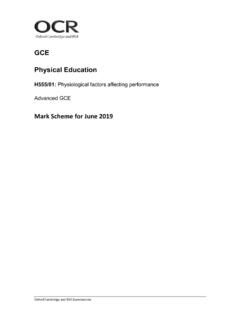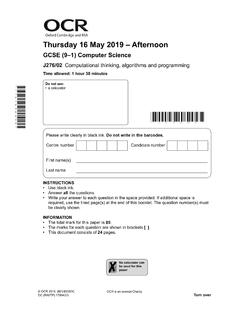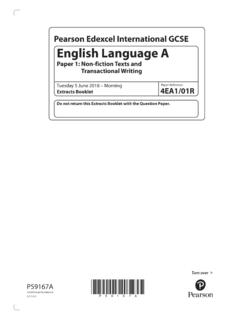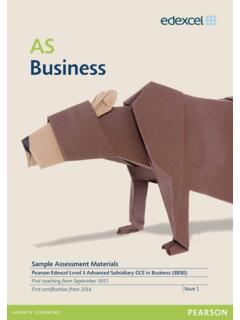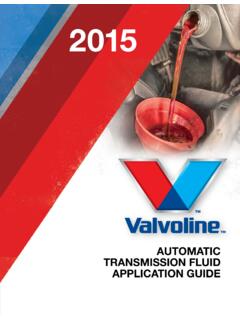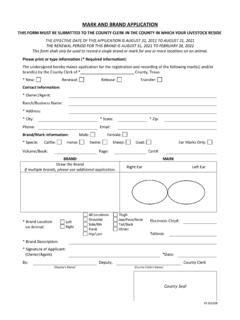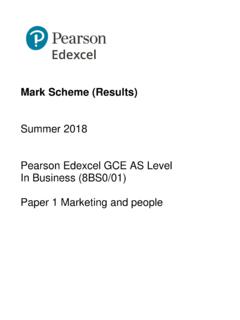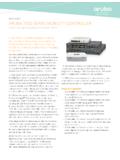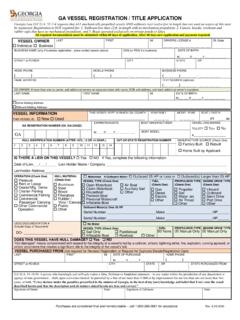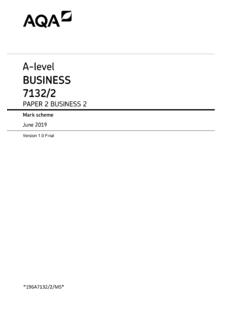Transcription of Mark Scheme (Results) - Revision World
1 Mark Scheme ( results ). Summer 2018. Pearson Edexcel GCE. In Business (9BS0). Paper 3 Investigating business in a competitive environment Edexcel and BTEC Qualifications Edexcel and BTEC qualifications are awarded by Pearson, the UK's largest awarding body. We provide a wide range of qualifications including academic, vocational, occupational and specific programmes for employers. For further information visit our qualifications websites at or Alternatively, you can get in touch with us using the details on our contact us page at Pearson: helping people progress, everywhere Pearson aspires to be the World 's leading learning company. Our aim is to help everyone progress in their lives through education. We believe in every kind of learning, for all kinds of people, wherever they are in the World . We've been involved in education for over 150 years, and by working across 70 countries, in 100 languages, we have built an international reputation for our commitment to high standards and raising achievement through innovation in education.
2 Find out more about how we can help you and your students at: Summer 2018. Publications Code 9BS0_03_1806_MS. All the material in this publication is copyright Pearson Education Ltd 2018. General Marking Guidance All candidates must receive the same treatment. Examiners must mark the first candidate in exactly the same way as they mark the last. Mark schemes should be applied positively. Candidates must be rewarded for what they have shown they can do rather than penalised for omissions. Examiners should mark according to the mark Scheme not according to their perception of where the grade boundaries may lie. There is no ceiling on achievement. All marks on the mark Scheme should be used appropriately. All the marks on the mark Scheme are designed to be awarded. Examiners should always award full marks if deserved, if the answer matches the mark Scheme .
3 Examiners should also be prepared to award zero marks if the candidate's response is not worthy of credit according to the mark Scheme . Where some judgement is required, mark schemes will provide the principles by which marks will be awarded and exemplification may be limited. When examiners are in doubt regarding the application of the mark Scheme to a candidate's response, the team leader must be consulted. Crossed out work should be marked UNLESS the candidate has replaced it with an alternative response. Question Indicative content Mark Number 1(a) Knowledge 2, Application 2, Analysis 2, Evaluation 2. marks for application and analysis include up to 2. marks for quantitative skills Quantitative skills assessed: QS2: calculate, use and understand percentages and percentages changes QS8: use and interpret quantitative and non-quantitative information in order to make decisions Branding is about creating an image or name that gives a product an identity which is recognizable and positive.
4 The more product branding, the greater the probability of sales. It therefore aids promotion and helps in creating, maintaining and increasing sales Benefits: The product branding in the table shows that for example Mars UK Ltd can achieve a greater number of sales in a market by having more products in 6 out of 10 highest positions amounting to in 2015, 64% of the top 10 added together, stronger than in 2014 when the same bars achieved out of 308m - 62%. Having a well known product brand could be transferable to other products, such as Mars milkshakes, which can increase sales further Or enable higher prices to be charged as consumers will come to trust the quality of the product (PED is relatively price inelastic). Possible counter-balance Branding can be expensive because of the need to develop new products, change production processes, packaging, advertising and marketing for such products as Mars bars.
5 Branding can also be negative if a single product suffers a problem such as food poisoning, the reputation of businesses may suffer and also the sales of its product range (8). Level Mark Descriptor 0 A completely inaccurate response. Level 1 1 2 Isolated elements of knowledge and understanding . recall based. Weak or no relevant application to business examples. Generic assertions may be presented. Level 2 3 5 Accurate knowledge and understanding Applied accurately to the business and its context. Chains of reasoning are presented, showing cause(s) and/or effects(s) but may be assertions or incomplete. An attempt at an assessment is presented, that is unbalanced and unlikely to show the significance of competing arguments. Level 3 6 8 Accurate and thorough knowledge and understanding, supported throughout by relevant and effective use of the business behaviour/context.
6 Logical chains of reasoning, showing cause(s). and/or effect(s). Assessment is balanced, well contextualised, using quantitative and/or qualitative information and shows an awareness of competing arguments/factors leading to a supported judgement. Question Indicative content Mark Number 1 (b) Knowledge 2, Application 2, Analysis 3, Evaluation 3. Flexible working is moving away from fixed tasks, working hours and locations Flexible working hours may make it easier to recruit and retain staff Value of having flexible working: Enables Nestle to have greater flexibility in the way they deploy their staff ability to vary the way of working whilst controlling costs. Finance staff would be able to work from home to complete Nestle's accounts, which could make them more productive as they will not waste time travelling to, and from the office Flexible job roles across different departments should allow Nestle to respond with the appropriate level of staffing to meet changes in demand in the chocolate market Marketing staff at Gatwick HQ may feel more motivated if they can take their dog to work which may increase productivity Possible counter-balance Production staff are unlikely to be able to work from home given the need to work with machinery and plant to make chocolate Staff without dogs may resent others who do take their dogs to work which might affect staff relations and productivity Dogs may be distracting.
7 So reduce productivity Home working staff may be less productive because they are not closely monitored (McGregor X-type employees). Possible judgement The success of flexible working as an approach to staffing, very much depends on the nature of the business and the job. It is less likely to be used in engineering and production occupations given that practicalities need to be overcome such as changing from one type of chocolate (10). bar to another on the production line Level Mark Descriptor 0 A completely inaccurate response. Level 1 1 2 Isolated elements of knowledge and understanding . recall based. Weak or no relevant application to business examples. Generic assertions may be presented. Level 2 3 4 Elements of knowledge and understanding, which are applied to the business example. Chains of reasoning are presented, but may be assertions or incomplete.
8 A generic or superficial assessment is presented. Level 3 5 6 Accurate and thorough knowledge and understanding, supported by relevant and effective use of the business behaviour/context. Analytical perspectives are presented, with chains of reasoning, showing cause(s) and/or effect(s). An attempt at an assessment is presented, using quantitative and qualitative information, though unlikely to show the significance of competing arguments. Level 4 7 10 Accurate and thorough knowledge and understanding, supported by relevant and effective use of the business behaviour/context. A coherent and logical chain of reasoning, showing cause(s) and/or effect(s). Assessment is balanced and well contextualised, using quantitative and qualitative information, and shows an awareness of competing arguments/factors leading to a supported judgement. Question Indicative content Mark Number 1(c) Knowledge 2, Application 2, Analysis 4, Evaluation 4.
9 Culture refers to shared attitudes, values, customs and expectations. Social differences come into play when different groups of people have different ways of communicating and ways of life. They affect consumer product preferences and patterns of consumption Packaging and ingredients will need to be adapted to suit the different languages and climates otherwise sales could suffer Important of: Changing eating habits in India, for example snacking, may have caused an increase in the demand for on-the-go convenience foods like chocolate As income in emerging economies increase, the demand for western products such as chocolate may rise Indian consumers appear to have a taste preference in favour of dark chocolate (dark Kit Kat Senses) and therefore production and sales should be aptly targeted Potential counterbalance Growing prosperity and incomes are more significant because chocolate is a luxury good to most consumers in the Indian economy Heavily marketed and branded chocolate such as Cadbury or Nestle may represent a status symbol to consumers so products will be sold regardless of taste Mistakes to do with unintended meanings, inappropriate or inaccurate translations are less common now given the growth of globalisation.
10 Possible judgement Businesses that want to expand into new markets must allow time to get to know their target markets by possibly seeking out partners and so may decide whether to have a joint venture, use local agents or employees who have a good understanding of the Indian chocolate/confectionary market. Consumer tastes and preferences need to be met not only in terms of the actual flavour and packaging of chocolate but also the appropriateness of its marketing campaigns. Celebrity endorsement through Bollywood actors in India for example, may be a way to combine a respect for culture with (12). promotional methods to increase sales. Level Mark Descriptor 0 A completely inaccurate response. Level 1 1 2 Isolated elements of knowledge and understanding . recall based. Weak or no relevant application to business examples. Generic assertions may be presented.
